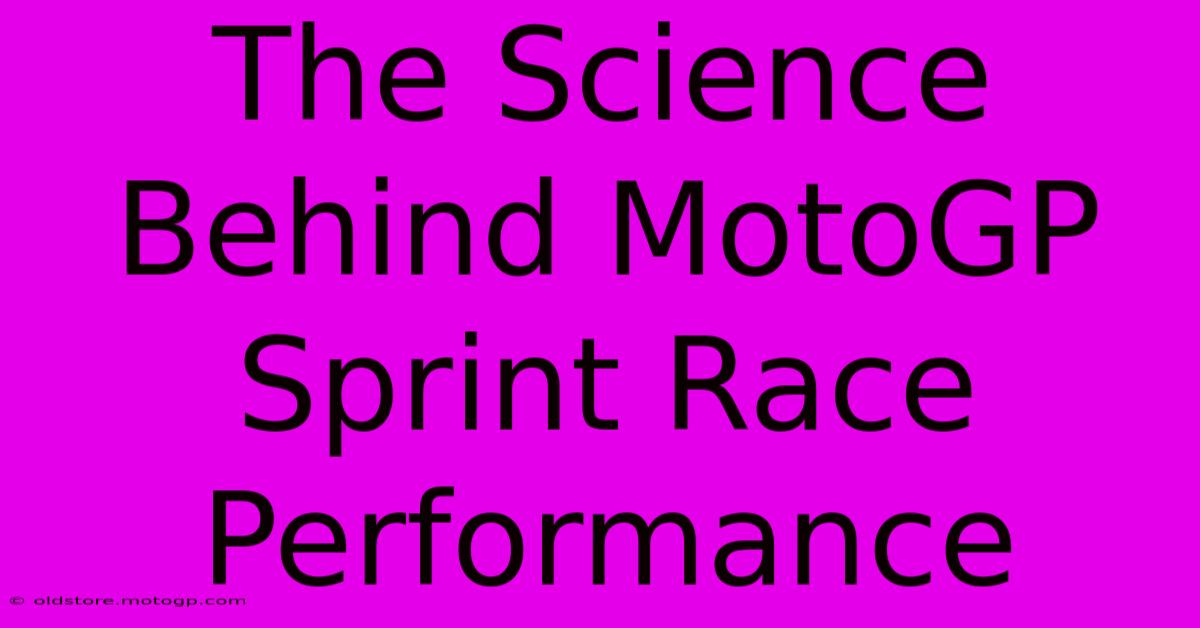The Science Behind MotoGP Sprint Race Performance

Table of Contents
The Science Behind MotoGP Sprint Race Performance
The roar of the engines, the blur of speed, the nail-biting finishes – MotoGP is a spectacle of athleticism and technological prowess. But beyond the adrenaline-fueled spectacle lies a complex interplay of science, strategy, and human endurance. The recent introduction of the Sprint race format has added another layer to this intricate equation, demanding a new level of performance analysis and rider adaptation. This article delves into the science behind maximizing performance in these shorter, more intense MotoGP Sprint races.
The Physics of a Short, Sharp Burst
Unlike the longer main races, Sprint races demand a different approach to fuel management, tire strategy, and even rider physicality. The short duration means there's less time for strategic maneuvering and more emphasis on raw speed and consistent lap times.
1. Tire Degradation:
Tire management is paramount in a Sprint race. The reduced race distance doesn't eliminate tire wear; instead, it necessitates a different strategy. Riders must push hard from the start, maximizing grip while mitigating the risk of excessive wear that could compromise performance in the closing laps. Understanding the tire's behavior under high stress and adapting riding styles accordingly is crucial. Data analysis plays a key role, allowing teams to predict tire degradation and optimize tire choice and pressure for the specific track conditions.
2. Fuel Consumption:
While fuel conservation is important in longer races, the shorter Sprint race format might seem to lessen its importance. However, minimizing fuel consumption still affects performance. Lighter fuel loads translate to improved handling and acceleration, crucial factors for overtaking and securing a strong grid position. Teams meticulously analyze fuel consumption data to find the optimal balance between fuel efficiency and performance.
3. Aerodynamics:
Aerodynamics play a vital role in top speed and cornering stability. The intense, close racing in Sprint races means that even small aerodynamic advantages can make a significant difference. Teams constantly refine their aerodynamic packages, seeking marginal gains in downforce and drag reduction to enhance performance. Computational fluid dynamics (CFD) simulations and wind tunnel testing are critical in achieving these improvements.
The Physiology of Peak Performance in Short Bursts
The human element is equally critical. Sprint races demand a specific type of physical and mental endurance.
1. Rider Fitness:
Rider fitness is tailored to the demands of short, intense bursts of energy. Training regimes emphasize anaerobic capacity, explosive power, and rapid recovery. Strength training, cardiovascular fitness, and mental resilience are all key components of a successful Sprint race strategy.
2. Reaction Time and Decision-Making:
In the fast-paced world of MotoGP, reaction time and decision-making are paramount. The margin for error in a Sprint race is exceptionally small, requiring riders to react instinctively and make split-second decisions, often under immense pressure. Simulations, virtual reality training, and intense race practice help hone these crucial skills.
3. Mental Fortitude:
The mental aspect cannot be underestimated. Mental fortitude is crucial for maintaining focus and concentration under extreme pressure. Mental training techniques, mindfulness, and visualization exercises play a significant role in optimizing rider performance in the high-stakes environment of a Sprint race.
Data-Driven Decisions: The Role of Technology
The science behind MotoGP Sprint race performance is significantly enhanced by technology.
1. Telemetry Data:
Telemetry data offers real-time insights into various aspects of bike and rider performance, including speed, acceleration, braking, lean angles, tire temperature, and engine parameters. This allows teams to make informed decisions during the race and optimize strategies for the next race.
2. Advanced Analytics:
Advanced analytics provide a deeper understanding of the data, revealing subtle patterns and correlations that could otherwise remain unnoticed. This allows for more precise fine-tuning of bike setup, riding style, and race strategy.
Conclusion: A Symphony of Science and Skill
The MotoGP Sprint race format presents a unique challenge, demanding a refined understanding of physics, physiology, and technology. It's a high-stakes dance between rider skill, machine performance, and data-driven optimization. The success in these shorter, more intense races hinges on the seamless integration of all these elements – a captivating symphony of science and skill. As the sport continues to evolve, the scientific analysis and technological advancements will only become more sophisticated, pushing the boundaries of performance even further.

Thank you for visiting our website wich cover about The Science Behind MotoGP Sprint Race Performance. We hope the information provided has been useful to you. Feel free to contact us if you have any questions or need further assistance. See you next time and dont miss to bookmark.
Featured Posts
-
American Moto Gp The Fight For The Championship
Feb 18, 2025
-
Find Your Next Victory Motorcycle Race Bikes Await
Feb 18, 2025
-
Cota Qualifying From Novice To Expert
Feb 18, 2025
-
Yesterdays Grand Prix A Must See Finish
Feb 18, 2025
-
Moto Gp Bike For Sale Conquer Any Corner
Feb 18, 2025
